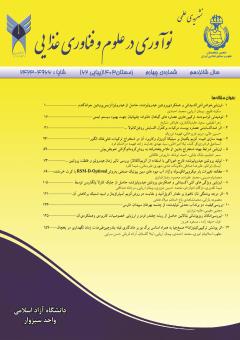ارزیابیفرمولاسیون پنیر پروسسگسترشپذیر با استفاده از ایزوله پروتئین نخود و پنیر لور
محورهای موضوعی : فرمولاسیون -بهینه سازیبهزاد اردلان 1 , محرم وزیری 2 , سید علی مرتضوی 3
1 - دانشآموخته دکتری، گروه علوم و صنایع غذایی، دانشکده کشاورزی، واحد سنندج، دانشگاه آزاد اسلامی ، سنندج، ایران.
2 - استادیار، گروه علوم و صنایع غذایی، دانشکده کشاورزی، واحد سنندج، دانشگاه آزاد اسلامی ، سنندج، ایران.
3 - استاد، گروه علوم و صنایع غذایی، دانشکده کشاورزی، دانشگاه فرودسی مشهد، مشهد، ایران
کلید واژه: پنیر لور, ایزوله نخود, پنیر پروسس,
چکیده مقاله :
استفاده از محصولات لبنی از دیرباز در رژیم غذایی انسان وجود داشته است و پنير یکی از قديميترين فرآوردههای شيري تولیدشده بهوسیله انسان میباشد که منبعی سرشار از مواد پروتئینی و مواد مغذی موردنیاز انسان است. در این تحقیق اثر مقادیر مختلف پودر ایزوله نخود (0، 2 و10 درصد) و پنیر لور (0، 10 و20 درصد) بر ویژگیهای میزان پروتئین، چربی، ماده خشک، سفتی، قابلیت جویدن و فنریت بررسی شد. نتایج در قالب طرح مرکب مرکزی(CCD) و به روش سطح پاسخ (RSM) مدلسازی و تجزیهوتحلیل شد. ضریب تبیین برای مدلهای رگرسیون برازش شده به ترتیب29/0، 97/0، 87/0، 96/0، 45/0 و 56/0بود. با توجه به نتایج بهدستآمده، اثر افزودن پنیر لور و ایزوله پروتئین نخود در سطوح مختلف معنیدار بود بهگونهای که بهکارگیری پنیر لور باعث افزایش مقدار پروتئین، چربی، ماده خشک، سفتی، فنریت و قابلیت جویدن پنیر پروسس تولیدی گردید، همچنین ایزوله نخود نیز اثر افزایش بر ویژگیهای موردبررسی بود و فقط قابلیت جویدن با حضور این ماده در حد ثابت ماند.
The use of dairy products has been in the human diet for a long time, and cheese is one of the oldest dairy products produced by humans, which is a rich source of protein and nutrients needed by humans. In this research, the effect of different amounts of isolated chickpea powder (0, 2 and 10%) and Lor cheese (0, 10 and 20%) on the characteristics of protein, fat, dry matter, firmness, chewability and springiness were investigated. The results were modeled and analyzed in the form of central composite design (CCD) and response surface method (RSM). The explanatory coefficient for the fitted regression models was 0.29, 0.97, 0.87, 0.96, 0.45 and 0.56 respectively. According to the obtained results, the effect of adding bay cheese and chickpea protein isolate was significant at different levels, such that the use of bay cheese increased the amount of protein, fat, dry matter, firmness, springiness and chewability of the processed cheese. Also, the chickpea isolate had an increasing effect on the examined characteristics, and only the chewing ability remained constant with the presence of this substance.
1. استاندارد ملی ایران به شماره 13418. 1396
2. Almeida K. E, Tamime A. Y, Oliveira M. N. Acidification rates of probiotic bacteria in Minas frescal cheese whey. LWTFood Science and Technology. 2008; 41: 311–316.
3. Bachmann H.-P. Cheese analogues: a review. International Dairy Journal. 2001;11(4–7): 505-515.
4. Balkır, P., & Metin, M. 2011. Physicochemical and textural properties of imitation fresh kashar cheeses prepared from casein, caseinates and soy protein. GIDA.36 (1): 17-24
5. Beliciu C. M, Moraru C. I. "The effect of protein concentration and heat treatment temperature on micellar casein–soy protein mixtures." Food Hydrocolloids. 2011; 25(6):1448-1460
6. Bolandi M. 2012. Introducing Formulation, Production Method and Physicochemical and Organoleptical Qualities and Microstructure of Arosheh Cheese and Chemical and Physical Qualities of Arosheh Oil- Research Plan.
7. Boye J.I, Aksay S, Roufik S, Ribéreau S, Mondor M, Farnworth E, Rajamohamed S.H. Comparison of the functional properties of pea, chickpea and lentil protein concentrates processed using ultrafiltration and isoelectric precipitation techniques. J. Food Research International. 2010; 43: 537–546.
8. Dhawan K, Malhotra S, Dahiya B. S, Singh D. Seed protein fractions and amino acid composition in gram (Cicer arietinum). Plant Foods for Human Nutrition. 1991; 41: 225–232.
9. Ferawati .F , Hefni , M., Östbring , K & Witthöft, C. The Application of Pulse Flours in the Development of Plant-Based Cheese Analogues: Proximate Composition, Color, and Texture Properties. Foods journal. 2021; 1-11. doi.org/10.3390/foods10092208.
10. Fox P. F, Guinee T.P, Cogan T. M, McSweeney P. H. 2000. “Fundamentals of Cheese Science.” ASPEN Publishers, Inc., Gaithersburg, Maryland.
11. Grasso N, Roos Y. H, Crowley S.V, Arendt E. K, O’Mahony J. A. Composition and physicochemical properties of commercial plant-based block-style products as alternatives to cheese. Future Foods. 2021;1-12.
/doi.org/10.1016/j.fufo.2021.100048
12. Hao X, Yang W, Zhu Q, Zhang G, Zhang X, Liu L, Li X, Hussain M. A, Ni C, Jiang X. Proteolysis and ACE-inhibitory peptide profile of Cheddar cheese: Effect of digestion treatment and different probiotics. LWT-Food Science and Technology. 2021; 145:111295.
https://doi.org/10.1016/j.lwt.2021.111295.
13. Kapoor R, Metzger L. Process Cheese: Scientific and Technological Aspects—A Review. Comprehensive Reviews in Food Science and Food Safety, 2008; 7:194–214.
14. Nishinari K, Fang Y, Guob S, Phillips G. O. Soy proteins: A review on composition, aggregation and emulsification. Food Hydrocolloids. 2014; 39(0): 301-318.
15. Pintado M. E, Malcata F. X. The effect of modified atmosphere packaging on the microbial ecology in Requeijao, a Portuguese whey cheese. Journal of food processing and preservation. 2000; 24(2):107-24.
16. Piska I, Stetina J. Influence of cheese ripening and rate of cooling of the processed cheese mixture on rheological properties of processed cheese. Journal of Food Engineering. 2004;61(4),551–555. 15th International Congress of Chemical Process Engineering (CHISA 2002), PRAGUE, CZECH REPUBLIC,
AUG 25-29, 2002. doi:10. 1016/S0260-8774(03)00217-6.
17. Sołowiej B, Mleko S, Gustaw. Effect of whey protein concentrates on texture, meltability and microstructure of acid casein processed cheese analogs. Article in Milchwissenschaft. 2010; 65(2):169-173.


